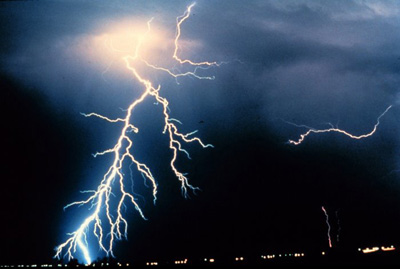What Causes Lightning
Introduction
People often wonder what causes lightning? How can a bolt of lightning suddenly appear when there are no storms within miles? Why is it if you can see lightning flash you are in danger and should seek shelter as quickly as you can. The reason for seeking shelter is that lightning can strike up to 10 miles away from any rainfall.

Lightning bolts during a thunderstorm. NOAA
What causes lightning on warm summer days
Lightning is the result of hot air near the surface
of the Earth heating up during warm days. The warm air begins rising in an
updraft that carries the warm air high above the surface of the Earth. The warm
air cools as it rises into the atmosphere. The air condenses as it cools forming water droplets. The water droplets freeze as they
move upward forming large cumulus clouds made of water and ice crystals.
What causes lighting with the formation of ice crystals
A thundercloud forms when the
water condenses as more warm air rises increasing the moisture in the cloud. The upper layer of the cumulus cloud is filled with water and ice crystals. The water and ice
crystals collide as the water moves around in the turbulent air in upper parts of the cumulus cloud.
Positively charged field of electrons develops
Downdrafts form from the weight of the cool water and ice crystals. The downdrafts push the air
downward stripping off some of the positive electron charges on the ice and
hail that have built up in the upper regions of the cloud. The
remaining ice crystals are positively charged forming a field of positively
charged particles.
Negatively charged field of electrons
The ice crystals as they
move downward in the downdraft become negatively charged and form another field
of electrons of negatively charged particles. This downdraft air movement
creates two electrical fields in the clouds that are separated with the positive
charge field at the top and the negatively charged field at the bottom.
What causes lightning is when these two fields become large enough to form giant sparks in the clouds. The excess positive and negative charged particles escape bringing the two fields of particles closer together.


Click for More Information and to Order
What causes lightning
What causes lightning is an electrical current that forms during thunderstorms. It is similar to static electricity that we feel when we shuffle our feet across a carpet and then touch a metal doorknob. Static electricity and lightning both have electrical fields with excess electrons that want to escape. What causes lightning bolts to form is the electrons jumping from one field in a cloud to another charged field.
Types of Lightning
- Intra-cloud lightning is the most common type of lightning. It occurs when lightning is jumping inside a cloud between different charges in different parts of the cloud. This type of lightning is sometimes called sheet lightning because it lights up the clouds like a sheet of light.
- Cloud to cloud lightning occurs when positive charges from one cloud and the negative charge from a different cloud create a bolt of lightning between the two clouds.
- Cloud to air lightning occurs at the top of clouds when the positive charged particles at the top of the thundercloud reaches out to negatively charged particles around the cloud creating a bolt of lightning.
- Bolt from the blue is the term used for lightning that starts in the updraft of a cloud about 2/3 of the way up and travels horizontally for several miles and then strikes the ground.
- Anvil lightning starts at the positively charged top of an anvil shaped cloud and travels straight down to the ground.
- Heat lightning occurs when the lightning is too far away to be heard.
What causes lightning bolts and static electricity
Static electricity is similar to a lightning bolt. Both have two fields of electrically charged particles. Static electricity occurs when a person wearing rubber soled shoes move across a carpet and stray electrons are picked on the shoe. The electrons build up a static charge that does not move but is looking for a way to escape. When a person touches a metal object such as a doorknob a small electrical spark forms as the electrons move from one object to another discharging the excess electrons.
A lightning bolt is similar to electrical spark formed by static electricity from a rubber soled shoe except it is much larger. Lightning bolts can reach 50,000° F. This is hotter than the surface of the Sun. The lightning bolts travel for such a short time they can strike a tree and not set it on fire even though it sometimes spirals down a tree as it moves toward the ground.
Lightning’s Warning Signs
If a thunderstorm in your area is producing lightning or might produce lightning in the near future you should the following warning signs and seek shelter immediately.
- Your hair suddenly stands on end
- Your skin begins to tingle
- Your palms suddenly begin to feel sweaty
- Light metal objects begin vibrate and start making a humming noise
- You suddenly feel a metallic taste in your mouth
- The air around you suddenly begins smelling like a swimming pool. This is the ozone in the air you are smelling.
- A nearby object begins to glow with a blue light.
How to stay safe so you won’t be struck by lightning
- No place outside is safe during a thunderstorm. You need to be proactive and seek immediate shelter that has a solid roof overhead when you think a thunderstorm is getting close. Especially if one of the warning signs above occurs.
- Go inside your home or some other large building with a roof. While inside a building DO NOT stay near windows or touch metal appliances.
- Most people hurt inside buildings by lightning are using their telephones that have a cord or are taking a shower.
- If you cannot get to a shelter when you are outside and a thunderstorm is coming your way stay away from the following:
- Anything that is isolated and stands tall above the ground such as a lone tree, flag pole or a telephone pole.
- Stay away from wide open areas such as a sports field, farmer’s field, or even a hiking trail.
- Move away from areas where there is water. Go ashore if you are boating or fishing. Do not lay on the beach during a thunderstorm.
More things to know about what causes lightning
- More than 50% of all deaths from lightning occur after the storm has passed.
- Lightning can strike up to 10 miles away from any rainfall.
- Rubber tires and rubber-soled shoes do not provide any protection from a bolt of lightning.
- 92% of all lightning injuries and deaths occur from May through September.
- Only about 10% of the people who are struck by lightning are killed. The remaining 90% suffer long term mental and health effects from being struck by lightning.
More Weather Links
Weather Facts: The weather affects our everyday lives throughout the year. Use the links on this page to learn about hurricanes, the Earths atmosphere layers, air pressure, lightning and thunderstorms.
Formation of hurricanes in North Pacific Ocean occurs in two basins. They are the two most active basins for cyclones to form on our planet. Meteorologist recognized the north eastern Pacific Ocean basin 1920s.
The Earths atmosphere layers are similar to the interior of the Earth. Find out about the four major layers of atmosphere that are separated by temperature.
What is air pressure? It is the weight of air molecules pressing down on the Earth. The pressure changes as you move upward into the atmosphere.
What causes lightning and what are the warning signs before lightning strikes? Find out on this fascinating page about lightning.
What are thunderstorm clouds and how do they form? Find out how severe thunderstorms produce rain, lightning, hail and occasionally tornadoes.
KIDS FUN Science Bookstore
Check out Myrna Martin's award winning textbooks, e-books, videos and rock sets. The Kids Fun Science Bookstore covers a wide range of earth science topics. Click here to browse.










